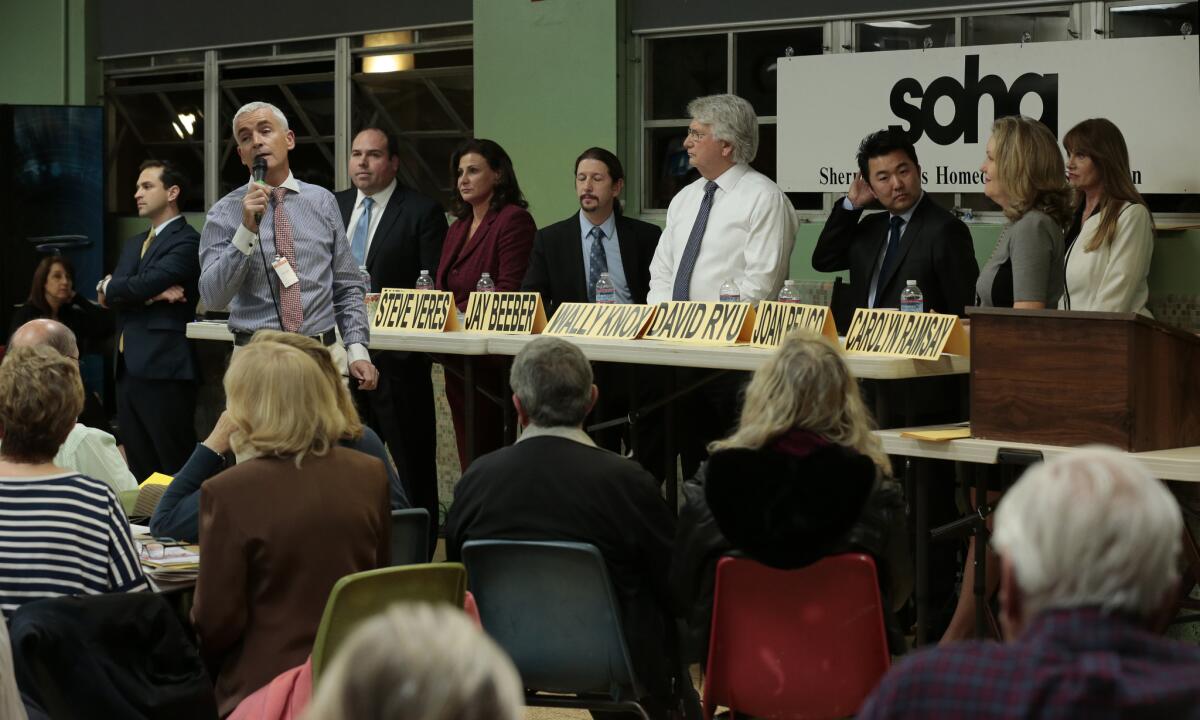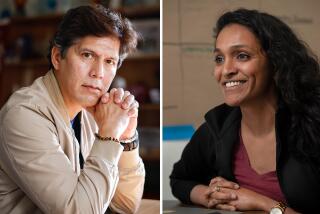Opinion: Why did voters sit out one of the most up-for-grabs races in years?

We’ve all been bemoaning the lowly 8.62% voter turnout for L.A. city elections Tuesday, but what I found truly depressing and puzzling was the low turnout for voters casting ballots in the City Council District 4 race.
This was the hotly contested campaign to replace Tom LaBonge, the long-serving, termed out councilman known for being the consummate old-school politician, out in the streets and parks, chatting up constituents, passing out pumpkin bread baked by a local order of nuns. Whether you thought he was fabulous or terrible, this was the first time in 12 years you absolutely had to put someone else in his job.
And 14 people wanted it. (Well, one guy who got certified for the election all but disappeared from the campaign trail.) They went to more than two dozen debates, jabbed at each other and proudly talked of walking from one end of the district to the other. No nagging problem in a district that sprawls from Sherman Oaks into Hollywood and east to Los Feliz was too huge -- or inconsequential -- for them to vow to fix (or try to fix): McMansions taking over neighborhoods, tourists taking over side streets on their way to the Hollywood sign, developers wooing council members into giving them variances for outsized projects, the planned closure of the Barham Boulevard southbound ramp off the 101 Freeway that has residents outraged.
How could anyone not vote?
Yet, out of 154,988 registered voters in District 4, there were 18,991 who voted for the council seat. That’s about 12.25% of the registered voters. Sure, it’s not as low as citywide. And those figures could very well go up. The L.A. City Clerk has about 46,412 ballots yet to be counted. Those are vote-by-mail ballots that got walked into the polls Tuesday and provisional ballots. On Wednesday, a spokesman for the clerk’s office said the office had no idea how many of those might be from District 4. (Of course, it’s unlikely they are all from District 4.)
But I had higher expectations for District 4. I watched this campaign as an editorial writer, I talked to people, I went to debates. One, in Sherman Oaks, was standing-room only. People on the sides of the room caught chatting with each other were sternly shushed by those in their seats. Wow, I thought -- who says voters are apathetic?
But what I saw as a bellwether of voter interest was, in fact, just a tiny subset of the already small subset of people in the district who voted.
That didn’t surprise -- or even worry -- some community activists I talked to Wednesday.
“You get all sorts of people concerned about cul-de-sacs and Beachwood Canyon and housing developments on Sepulveda Boulevard, and they pay attention and try to relate it to the election,” said John Welborne, an attorney and the vice president of planning and land use for the Windsor Square Assn. He’s fine with that dedicated group, alone, voting. “I’d much rather have fewer informed voters than many more herded voters.”
I’d like to think it’s not an either-or proposition. I’d rather have lots more voters who happen to be informed. So what happened in District 4? People don’t really believe the new council member can keep the Barham exit open and tourists away from the Hollywood sign? (And, they’d be right to think the council member will have his or her hands full trying to do either.) Or do they just not care about that and a variety of other issues?
“I know a lot of people who got totally overwhelmed by the number of candidates and will only vote in the general election,” said James O’Sullivan, the Miracle Mile Residential Assn. president who followed the race closely and got almost all the candidates to sign a pledge agreeing -- if he or she won -- to make public any approach from a developer pushing a project in the district.
So, essentially those folks allowed other voters to narrow the field for them to the two top vote-getters, Carolyn Ramsay and David Ryu, who will go on to the general election -- unless the count changes based on the ballots the city clerk hasn’t dealt with yet. Ryu and Ramsay also raised the most money of all the candidates running. Money often gets spent on direct mail and advertising. Although O’Sullivan said he thinks the fliers stuffed into people’s mailboxes “by and large did not connect with the general public.” (Sheila Irani, who came in seventh, told me a voter emailed her to say she was voting for her because she did not send her direct mail.)
O’Sullivan is not alone in chalking up low voter turnout to overall disenchantment with elected officials. “The connection between office holders and those who elect them has been severed. I think only smaller districts or boroughs that candidates can walk and hold town halls in will generate higher vote totals.”
Which is exactly why I thought District 4 would draw a relatively healthy turnout -- because it felt, to me, like a district full of people who went to debates and had a history of connecting with and expecting much from their council member. But what I saw was obviously just a sliver of the district. Let’s hope the newly narrowed field of candidates does a better job of drawing out the people who skipped the primary.
Follow the Opinion section on Twitter @latimesopinion
More to Read
A cure for the common opinion
Get thought-provoking perspectives with our weekly newsletter.
You may occasionally receive promotional content from the Los Angeles Times.







